I have been trying to change the projection of Shapefile from one coordinate reference system to other. The shapefile I have used has EPSG:4326 as its reference system and I need to change it to EPSG:32056. I am using Geotools API-20.0 for the same.
I have already tried various methods available in the geotools like using ReprojectingFeatureCollection, use of JTS, use of Query API to convert the shapefile directly to the other coordinate reference system
import java.awt.event.ActionEvent;
import java.io.File;
import java.io.InputStream;
import java.io.Serializable;
import java.net.URI;
import java.net.URL;
import java.util.HashMap;
import java.util.Map;
import java.util.Set;
import javax.swing.Action;
import javax.swing.JButton;
import javax.swing.JOptionPane;
import javax.swing.JToolBar;
import javax.swing.SwingWorker;
import org.geotools.data.DataStore;
import org.geotools.data.DataStoreFactorySpi;
import org.geotools.data.DefaultTransaction;
import org.geotools.data.FeatureWriter;
import org.geotools.data.FileDataStore;
import org.geotools.data.FileDataStoreFinder;
import org.geotools.data.Query;
import org.geotools.data.Transaction;
import org.geotools.data.shapefile.ShapefileDataStoreFactory;
import org.geotools.data.simple.SimpleFeatureCollection;
import org.geotools.data.simple.SimpleFeatureIterator;
import org.geotools.data.simple.SimpleFeatureSource;
import org.geotools.data.simple.SimpleFeatureStore;
import org.geotools.feature.simple.SimpleFeatureTypeBuilder;
import org.geotools.geometry.jts.JTS;
import org.geotools.geometry.jts.ReferencedEnvelope;
import org.geotools.map.FeatureLayer;
import org.geotools.map.Layer;
import org.geotools.map.MapContent;
import org.geotools.referencing.CRS;
import org.geotools.referencing.ReferencingFactoryFinder;
import org.geotools.referencing.factory.gridshift.GridShiftLocator;
import org.geotools.styling.SLD;
import org.geotools.styling.Style;
import org.geotools.swing.JMapFrame;
import org.geotools.swing.JProgressWindow;
import org.geotools.swing.action.SafeAction;
import org.geotools.swing.data.JFileDataStoreChooser;
import org.locationtech.jts.geom.Envelope;
import org.opengis.feature.Feature;
import org.opengis.feature.FeatureVisitor;
import org.opengis.feature.simple.SimpleFeature;
import org.opengis.feature.simple.SimpleFeatureType;
import org.opengis.feature.type.FeatureType;
import org.opengis.referencing.crs.CoordinateReferenceSystem;
import org.opengis.referencing.operation.MathTransform;
import org.opengis.util.ProgressListener;
import com.vividsolutions.jts.geom.Geometry;
public class CRSLab {
private File sourceFile;
private SimpleFeatureSource featureSource;
private MapContent map;
public static void main(String[] args) throws Exception {
CRSLab lab = new CRSLab();
lab.displayShapefile();
}
// docs end main
/**
* This method:
* <ol type="1">
* <li>Prompts the user for a shapefile to display
* <li>Creates a JMapFrame with custom toolbar buttons
* <li>Displays the shapefile
* </ol>
*/
// docs start display
private void displayShapefile() throws Exception {
sourceFile = JFileDataStoreChooser.showOpenFile("shp", null);
if (sourceFile == null) {
return;
}
FileDataStore store = FileDataStoreFinder.getDataStore(sourceFile);
featureSource = store.getFeatureSource();
// Create a map context and add our shapefile to it
map = new MapContent();
Style style = SLD.createSimpleStyle(featureSource.getSchema());
Layer layer = new FeatureLayer(featureSource, style);
map.layers().add(layer);
// Create a JMapFrame with custom toolbar buttons
JMapFrame mapFrame = new JMapFrame(map);
mapFrame.enableToolBar(true);
mapFrame.enableStatusBar(true);
JToolBar toolbar = mapFrame.getToolBar();
toolbar.addSeparator();
toolbar.add(new JButton(new ValidateGeometryAction()));
toolbar.add(new JButton(new ExportShapefileAction()));
// Display the map frame. When it is closed the application will exit
mapFrame.setSize(800, 600);
mapFrame.setVisible(true);
}
// docs end display
// docs start export
private void exportToShapefile() throws Exception {
SimpleFeatureType schema = featureSource.getSchema();
JFileDataStoreChooser chooser = new JFileDataStoreChooser("shp");
chooser.setDialogTitle("Save reprojected shapefile");
chooser.setSaveFile(sourceFile);
int returnVal = chooser.showSaveDialog(null);
if (returnVal != JFileDataStoreChooser.APPROVE_OPTION) {
return;
}
File file = chooser.getSelectedFile();
if (file.equals(sourceFile)) {
JOptionPane.showMessageDialog(null, "Cannot replace " + file);
return;
}
// set up the math transform used to process the data
CoordinateReferenceSystem dataCRS = schema.getCoordinateReferenceSystem();
CoordinateReferenceSystem worldCRS = CRS.decode("EPSG:32056", true);// map.getCoordinateReferenceSystem();
boolean lenient = true; // allow for some error due to different datums
MathTransform transform = CRS.findMathTransform(dataCRS, worldCRS, lenient);
// grab all features
SimpleFeatureCollection featureCollection = featureSource.getFeatures();
// And create a new Shapefile with a slight modified schema
DataStoreFactorySpi factory = new ShapefileDataStoreFactory();
Map<String, Serializable> create = new HashMap<String, Serializable>();
create.put("url", file.toURI().toURL());
create.put("create spatial index", Boolean.TRUE);
DataStore dataStore = factory.createNewDataStore(create);
SimpleFeatureType featureType = SimpleFeatureTypeBuilder.retype(schema, worldCRS);
dataStore.createSchema(featureType);
String createdName = dataStore.getTypeNames()[0];
// carefully open an iterator and writer to process the results
Transaction transaction = new DefaultTransaction("Reproject");
FeatureWriter<SimpleFeatureType, SimpleFeature> writer = dataStore.getFeatureWriterAppend(createdName,
transaction);
SimpleFeatureIterator iterator = featureCollection.features();
try {
int counter = 0;
while (iterator.hasNext()) {
// copy the contents of each feature and transform the geometry
SimpleFeature feature = iterator.next();
SimpleFeature copy = writer.next();
org.locationtech.jts.geom.Geometry geometry = (org.locationtech.jts.geom.Geometry) feature
.getDefaultGeometry();
org.locationtech.jts.geom.Geometry geometry2 = JTS.transform(geometry, transform);
System.out.println(geometry.isSimple() && geometry2.isSimple());
// if (geometry2.isValid()) {
copy.setAttributes(feature.getAttributes());
counter++;
copy.setDefaultGeometry(geometry2);
writer.write();
// }
}
transaction.commit();
System.out.println("valid geometries : " + counter);
JOptionPane.showMessageDialog(null, "Export to shapefile complete");
} catch (Exception problem) {
problem.printStackTrace();
transaction.rollback();
JOptionPane.showMessageDialog(null, "Export to shapefile failed");
} finally {
writer.close();
iterator.close();
transaction.close();
}
}
// docs end export
// docs start validate
private int validateFeatureGeometry(ProgressListener progress) throws Exception {
final SimpleFeatureCollection featureCollection = featureSource.getFeatures();
// Rather than use an iterator, create a FeatureVisitor to check each
// fature
class ValidationVisitor implements FeatureVisitor {
public int numInvalidGeometries = 0;
public void visit(Feature f) {
SimpleFeature feature = (SimpleFeature) f;
Geometry geom = (Geometry) feature.getDefaultGeometry();
if (geom != null && !geom.isValid()) {
numInvalidGeometries++;
System.out.println("Invalid Geoemtry: " + feature.getID());
}
}
}
ValidationVisitor visitor = new ValidationVisitor();
// Pass visitor and the progress bar to feature collection
featureCollection.accepts(visitor, progress);
return visitor.numInvalidGeometries;
}
// docs end validate
// docs start export action
class ExportShapefileAction extends SafeAction {
ExportShapefileAction() {
super("Export...");
putValue(Action.SHORT_DESCRIPTION, "Export using current crs");
}
public void action(ActionEvent e) throws Throwable {
exportToShapefile();
}
}
// docs end export action
/**
* This class performs the task of checking that the Geometry of each
* feature is topologically valid and reports on the results. It also
* supplies the name and tool tip.
*/
// docs start validate action
class ValidateGeometryAction extends SafeAction {
ValidateGeometryAction() {
super("Validate geometry");
putValue(Action.SHORT_DESCRIPTION, "Check each geometry");
}
public void action(ActionEvent e) throws Throwable {
int numInvalid = validateFeatureGeometry(null);
String msg;
if (numInvalid == 0) {
msg = "All feature geometries are valid";
} else {
msg = "Invalid geometries: " + numInvalid;
}
JOptionPane.showMessageDialog(null, msg, "Geometry results", JOptionPane.INFORMATION_MESSAGE);
}
}
// docs end validate action
}
The output obtained after doing projection using Geotools are a lot different than what I used to get from ArcMap of esri. Is there any other transformation that I should perform.


